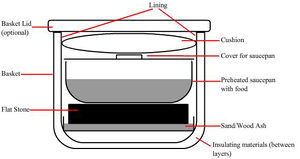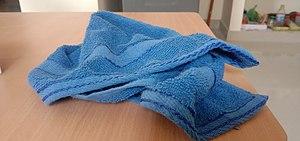
The fireless cooker, retained heat cooker or food warmer can be built with locally available materials and is used to keep food warm and to allow the cooking of food with less fuel.
To use a fireless cooker, first bring food to the boiling point using a three stone or improved cookstove, or gas or electric stove. The stove can now be extinguished and the food is put into the fireless cooker which is well insulated and keeps the food from cooling down.
Benefits - cheap, safe, convenient and cool[edit | edit source]
The food cooks slightly slower than if it was directly on the stove, but the saving in firewood can be large.
It has many advantages in convenience - it is portable, and can be carried around easily. A well made fireless cooker can keep food warm for up to 8 hours after it has been heated, taking away the need to plan exactly when the food must be ready. Also, it does not require watching the stove,
There is no risk of burning a pot in a fireless cooker, and there is no flame to cause a household fire or health problems (indoor air pollution).
Much less heat is produced - only a fraction of that produced in regular cooking. This heat might otherwise flow into the rest of the house, as well as making the kitchen uncomfortable. Thus it can save energy and money on air-conditioning. This is especially valuable in a warm or hot climate, or in a small or poorly-ventilated kitchen.
Towel cooking[edit | edit source]

Towel cooking is the simplest way for most people to do Fireless cooking, either to save fuel, electricity and reduce emissions, or for convenience.
Place a towel on the kitchen bench or table. Choose a safe spot. Never use textile towels near a gas stove!
Any towel can work;[1] but the bigger and thicker the towel is, the better the insulation and the more effective the cooking will be. For additional insulation, place a thick and flat piece of hardwood, a heatmat or trivet under the towel, where the pot will sit.
Preboil water in an electric water kettle. Pour the hot water into a pot or pan on a hotplate or stove. This will bring the pot quickly to a simmer. Pour the food that you want to boil into the pot and put a lid on very quickly. A lid on a cooker and sauce pan should fit tight to retain the steam and heat inside for maximum efficiency.
Remove from the heat to the towel. Wrap the towel around the pot tightly. Be careful so you not burn your hands.
Cooking soft food[edit | edit source]
e.g. bananas, potatoes, rice - Bring to the boil on the stove for 3 mins then put into the fireless cooker. In 25 minutes it should be ready to eat!
Cooking hard food[edit | edit source]
e.g. beans (pre soaked), beef, chicken - Bring to boil on the stove for 20-25 mins then put into the fireless cooker. In 2-2½ hrs it should be ready to eat!
Food safety[edit | edit source]
It is important that food is brought to a boil for an adequate time, as described above, particularly for foods such as meats or beans. This will help to kill any pathogens, so they will not grow back too quickly when the temperature drops. With legumes (especially kidney beans and chickpeas), food poisoning is possible if they are not cooked at a high enough temperature - but with pre-soaking and then boiling for 20-25 minutes, this should not be a problem.
Simply warming or partially reheating food, then keeping it warm in the fireless cooker, is potentially dangerous, especially if the food is left for a long time, as the warm temperature will allow pathogens to grow more quickly.
Materials and Requirements[edit | edit source]
- Basket - A simple basket that can be bought cheaply from any market - a bag or paper box could alternatively be used. It needs to be large enough to house a saucepan inside
- Lining material - e.g Jute, cotton, wollen, bark cloth (normally an piece of material from an old sack is used)
- Flat stone (clay is best)
- Sand or wood ash
- Metallic plate
- Material to use as thread
- Large needle for sewing the bag
- Insulation material - e.g cotton, woodshavings, dried grass, paper, dry leaves
Construction[edit | edit source]
- The basket is the main structure of the fireless cooker. On the inside of the basket will be a lining made from the lining material. In between these two layers, the insulation material is stuffed. This ensures that no heat is lost from the cooker
- Take the lining material and cut it so it can be used as a lining for the bag. It needs to be slightly bigger than the basket as the lining is attached on the outside of the basket (see image)
- Take the basket and very densely pack with insulation material. Place the lining on top (at this point ensure that the saucepan just fits inside. If not remove some insulation until it does.
- Sew the lining to the outside of the basket (see image)
- The metallic plate is now put inside the basket, it is filled with the sand/wood ash and the stone is put on top of the plate. This ensures that the heat of the saucepan is evenly spread
Cushion[edit | edit source]
- To cushion is put on top of the saucepan to ensure no heat escapes. This is made out of the lining material and should be exactly the width of the basket
- Make two identical pieces of lining material, making them of a diameter slightly larger than the basket. Sew them together except for a small gap
- Stuff the gap very densely with insulation material. Than complete the cushion by sewing the gap
The cross section shows how the stove is used with food
Photos[edit | edit source]
Fireless cooker in construction
Uses[edit | edit source]
The fireless cooker is a common appropriate technology used in sub-Saharan Africa.[verification needed]
Electricity powered cooking[edit | edit source]
Electric cookstoves
Gas powered stoves are common in households all across the world. Gas has been shown to be inefficient and dangerous when compared to electricity powered cookstoves [1].[verification needed] There are a variety of different types and sizes of electric stoves that can be utilized on a residential scale and commercial scale. The implementation of electric ranges will incur cost savings and health benefits.[verification needed]
External links[edit | edit source]
- Here are a few other examples of fireless cookers using similar methods
- http://web.archive.org/web/20130513061151/http://www.daenvis.org:80/technology/FirelessCooker.htm
- Building a fireless cooker in Malawi (pdf file) - http://web.archive.org/web/20081001104637/http://www.probec.org:80/docs/Foodwarmer.pdf
- Haybox, Retained Heat or Fireless Cooker
- Heat-retention cooking on the Solar Cooking Archive Wiki
- George Washington Carver: Fireless Cooker and Canning Jars (old designs).
- ↑ Even a tea towel draped over the pot will have some effect. In warm weather, the pot will continue cooking for a short while even without being wrapped. However wrapping in a full sized towel will work much better.